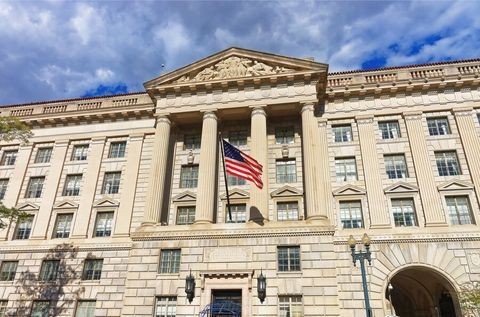DOJ's & EPA's First Take on the Tax Cuts and Jobs Act (TCJA)
Client Alert | 5 min read | 06.14.18
Since our prior alert, Tax Reform Impacts Governmental Environmental Enforcement, there have been a number of important developments regarding the TCJA and tax reform. In mid-May 2018, DOJ and EPA sent letters to the IRS in response to its request for comments on proposed regulations. And on May 25, taxpayers got the first look – via the apparent first consent decree entered into since the law’s enactment – at how DOJ and EPA are handling tax reform’s new identification requirement.
About the TCJA: Section 162(f)’s new identification requirement and section 6050X reporting obligation
Under the TCJA, environmental enforcement payments made for purposes of restitution or to come into compliance with the law are generally deductible. The payment can be deducted only if it is identified as “restitution” or a “compliance payment” in the relevant court order or settlement agreement. Although this label is necessary, it is not sufficient. Also, the TCJA imposes a new reporting requirement on governmental entities. If a governmental entity receives a payment exceeding $600 pursuant to an order or agreement, it must report the amount to the IRS and the taxpayer. Congress, however, gave the IRS authority to change the minimum reporting amount in the Code. The report must also separately identify any amounts that are for restitution, remediation of property, or correction of noncompliance. Companies must also comply with the other requirements in sections 162(f) and 6050X.
The IRS’s request for comments for rulemaking and the EPA’s and DOJ’s responses
In April, the Treasury Department and the IRS announced that it planned to issue proposed regulations implementing the new law. To assist in the development of these rules, the IRS asked interested parties to offer comments on several important issues, including the threshold amount for reporting under the governmental reporting requirement; any anticipated administrative difficulties in securing information needed to report the amount; and how to define key terms under the statute.
Both EPA and DOJ responded to the IRS’s request. On May 17, EPA urged the IRS not to require government agencies to report the value of settlements (i.e., a specific dollar figure). Instead, any new rule should shift the reporting burden to the company altogether or allow agencies to identify specific provisions in the agreement that describe the performance meant to constitute restitution or compliance (e.g., remediation of property or installation of a pollution-control technology). As EPA explained in its letter, EPA and similar agencies generally do not know and cannot verify the total amount that a company will spend to remediate property or achieve compliance, even after the case concludes. Also, EPA suggested that the new law should not apply to the majority of settlements relating to CERCLA. CERCLA, EPA explained, is a remedial statute under which liability generally does not depend on a violation of law. Because section 162(f) applies “to the violation of any law,” the new law does not seem to apply in the CERCLA settlement context.
In its May 18 letter, DOJ, among other things, added that the $600 reportable amount was too low and should be raised to $10 million. DOJ contended that such a small threshold would make the reporting obligation burdensome to federal and state agencies. The larger amount, said DOJ, appropriately reflected the more significant matters that the department handled.
DOJ recently applied the new identification requirement
On May 25, the DOJ filed what appears to be the first consent decree with section 162(f)’s identification language. In United States, et al. v. Columbian Chemicals Company, the United States and state of Louisiana alleged Clean Air Act violations against a carbon-black producer. The parties reached a settlement that required the company to install state-of-the-art pollution controls (estimated to cost $100 million), pay civil penalties of $650,000, and perform environmental remediation projects valued at $375,000.
The parties filed the consent decree for the court’s approval on December 22, 2017—the same day that President Trump signed the TCJA into law. Under the new law, the company would not be able to deduct the cost of installing the controls because the decree did not identify the payments as restitution or compliance payments under section 162(f). On May 25, the Department of Justice filed an unopposed motion to enter a revised consent decree. The DOJ stated that the revised consent decree was identical to the original decree except that it added language complying with section 162(f)’s identification requirement. The DOJ explained that the addition of this language did not change the substance of the consent decree.
The consent decree states that: “For purposes of the identification requirement of Section 162(f)(2)(A)(ii) of the Internal Revenue Code, 26 U.S.C. § 162(f)(2)(A)(ii), performance of [various paragraphs in the consent decree and appendices] is restitution or required to come into compliance with law.” The consent decree does not identify the specific amount of the restitution payments or compliance payments.
Modified consent decree: unclear how estimated amounts will be reported to the IRS
The lack of a specific amount in the Columbian Chemicals Company consent decree illustrates one of the issues with the new law: How are estimated amounts reported to the IRS? As mentioned, the government must file an information return with the IRS for payments above $600 and separately report the amounts that the taxpayer paid for restitution, for example.
DOJ did not have to file an information return with respect to the Columbian Chemicals Company settlement because the IRS has temporarily suspended the filing requirement. On March 27, 2018, the IRS suspended the reporting requirement until at least January 1, 2019. If the reporting requirement had not been suspended, it is unclear what amounts the DOJ would report to the IRS and the tax consequence if Columbian Chemicals Company ultimately pays a different amount. Would DOJ report the estimated amount of $100 million? If DOJ reports $100 million but Columbian Chemicals Company pays $110 million to install the pollution controls, is it limited to a deduction of $100 million? The IRS will hopefully answer these questions in the upcoming regulations. Depending on these rules, taxpayers should have agreements with the DOJ that it will amend any information returns in the event the payment exceeds the estimated amount.
Conclusion
DOJ and EPA are fully engaged in the statute’s rulemaking process. And via this revised consent decree, they are willing to work with companies to include section 162(f)’s identification requirement. This willingness to cooperate will be important for the other carbon-black manufacturers – Sid Richardson Carbon, Ltd. and Orion Engineered Carbons, LLC – that had similar consent decrees. It will also serve as precedent for another Clean Air Act consent decree in United States v. Exxon, where Exxon and federal and state agencies are attempting to amend their agreement filed in late 2017. We expect more developments re the TCJA and tax reform as 2018 continues.
Contacts
Insights
Client Alert | 4 min read | 09.20.24
Department of Commerce Unveils New Tool to Inform Supply Chain Risk Mitigation
The U.S. Department of Commerce unveiled a groundbreaking analytic risk assessment tool to inform the U.S. government’s efforts in mitigating supply chain risks. Launched at the inaugural Supply Chain Summit hosted by the Department of Commerce and the Council on Foreign Relations on September 10, 2024, the SCALE Tool marks a significant milestone in the U.S. government’s broader commitment to strengthening the U.S. supply chain ecosystem.
Client Alert | 3 min read | 09.13.24
Client Alert | 12 min read | 09.13.24
Tri-Agencies Finalize NQTL Comparative Analysis Standards in Final Rule
Client Alert | 5 min read | 09.11.24



